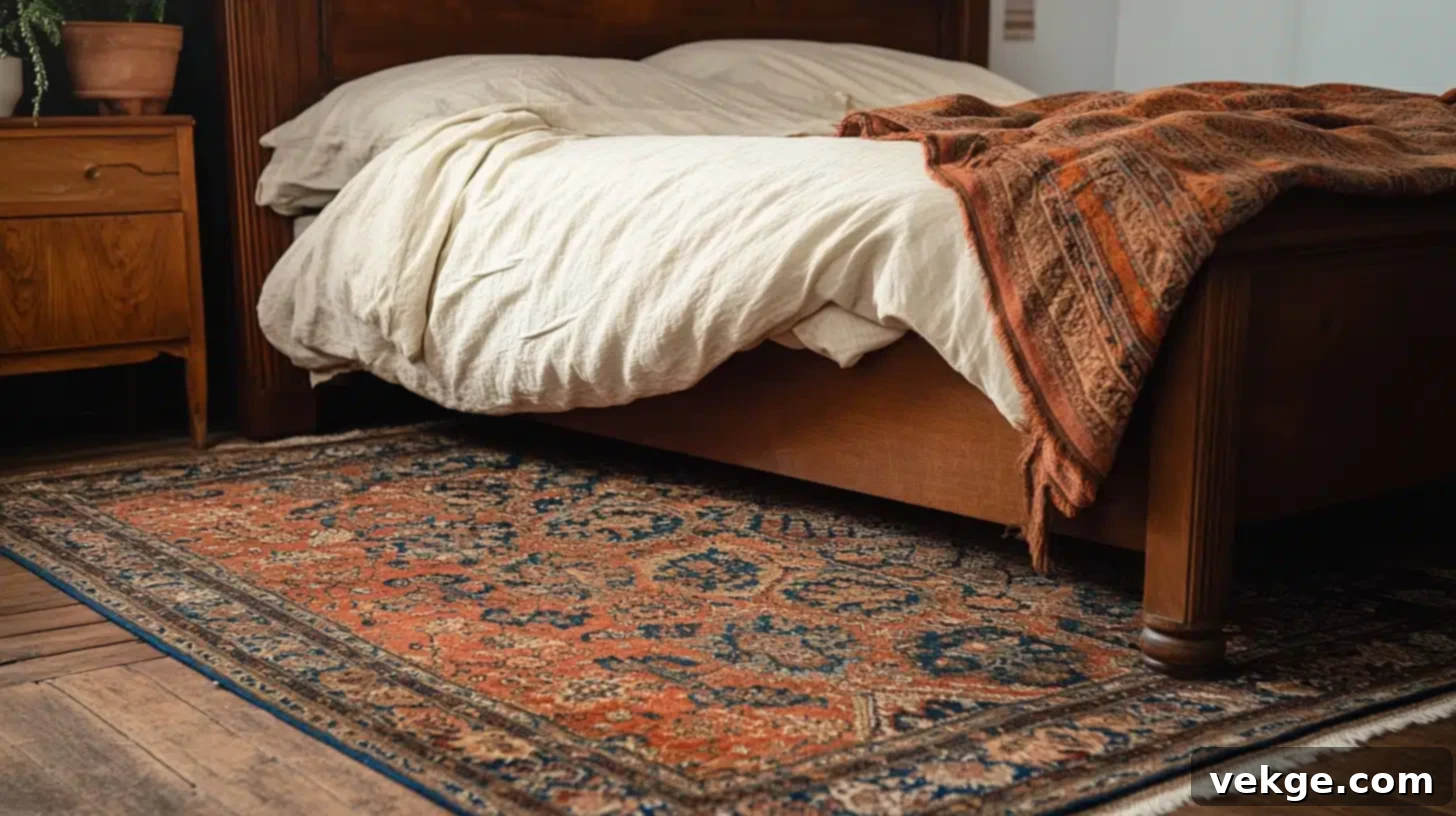The Ultimate Guide to Placing a Rug Under Your Bed for a Stylish & Cozy Bedroom
A rug under your bed isn’t just a floor covering; it’s a transformative element that can elevate your entire bedroom’s aesthetic and comfort. It adds warmth, texture, and a foundational anchor to your sleeping space, turning a simple room into a luxurious sanctuary. However, choosing the right rug and positioning it perfectly can feel like a daunting task. This comprehensive guide is designed to demystify the process, helping you select the ideal rug and place it with confidence.
We’ll cover every essential aspect, from understanding the various benefits a well-placed rug offers, to determining the perfect size and shape for your specific bed and room dimensions. You’ll learn several expert techniques for positioning, explore aesthetic considerations like how rugs impact spatial perception, and discover practical tips for installation and long-term maintenance. Whether you’re furnishing a spacious master bedroom or optimizing a compact guest room, our advice will help you create a cohesive and inviting environment.
By the time you finish reading, you’ll be equipped with all the knowledge needed to use a rug to its full potential, making your bedroom not just stylish, but profoundly comfortable and uniquely yours. Let’s embark on this journey to make your bedroom floor a stunning focal point!
Unlock the Benefits: Why the Right Bedroom Rug Matters
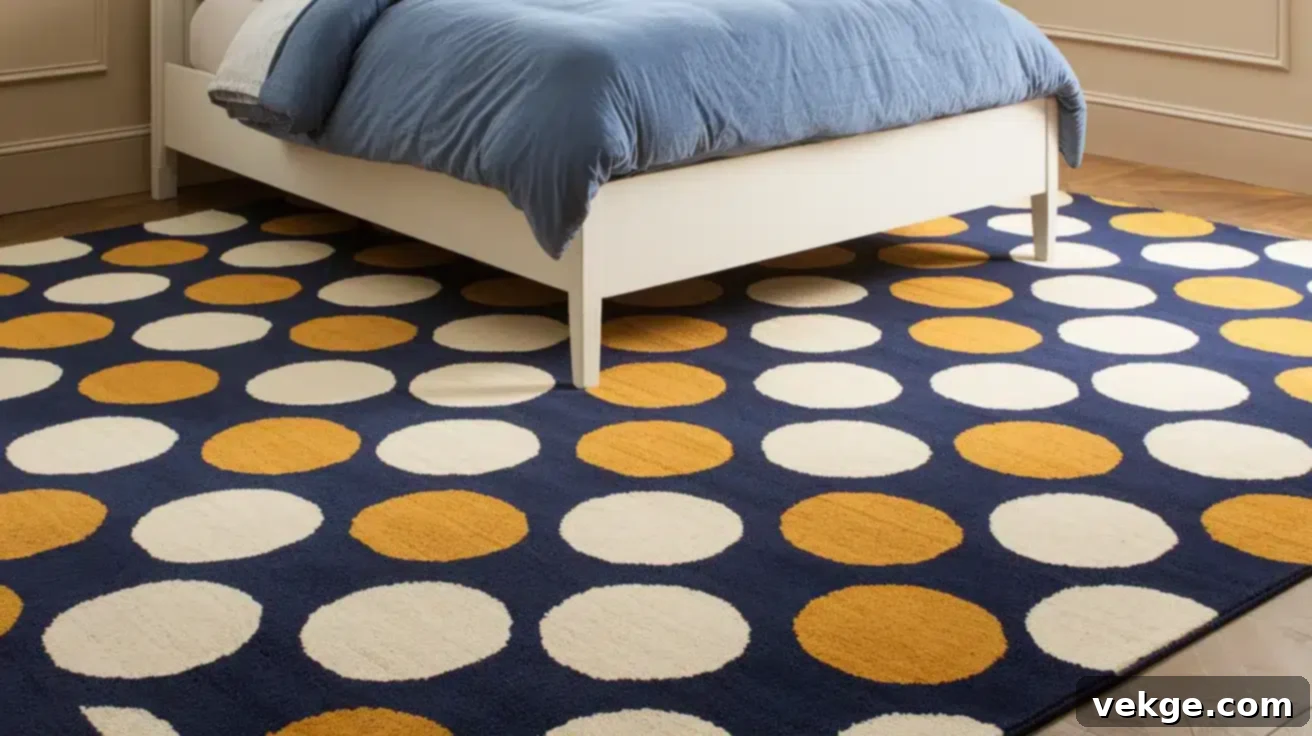
Before diving into the specifics of selection and placement, it’s crucial to understand the myriad advantages a carefully chosen rug brings to your bedroom. A well-integrated rug serves multiple functions beyond mere decoration, enhancing both the practicality and the ambiance of your space:
- Floor Protection: Heavy bed frames and frequent foot traffic can cause wear and tear on hardwood, laminate, or even carpeted floors. A sturdy rug acts as a protective barrier, shielding your flooring from scratches, dents, and scuffs caused by furniture legs or accidental spills. It’s an investment in preserving your home’s existing finishes.
- Express Your Personal Style: A rug is a powerful design tool that instantly communicates your personal taste. Whether you prefer minimalist chic, bohemian vibrancy, classic elegance, or modern abstract, the color, pattern, and texture of your rug can set the entire tone for your bedroom. It allows you to introduce bold statements or subtle accents.
- Create a Defined Focal Point: When strategically placed, a rug can expertly anchor your bed, turning it into the undeniable centerpiece of the room. It draws the eye and helps to ground the largest piece of furniture, creating a sense of order and balance within the space.
- Conceal Imperfections: If your existing flooring has blemishes, stains, or simply lacks visual appeal, a rug offers an elegant and effective solution to conceal these flaws. It can cover worn-out carpet, scuffed hardwood, or outdated tile, providing an instant upgrade without costly renovations.
- Improve Acoustics and Reduce Noise: Hard surfaces tend to echo, making a room feel noisy and less inviting. Rugs absorb sound waves, significantly reducing echoes and creating a quieter, more tranquil environment. This is particularly beneficial in bedrooms, promoting a sense of calm conducive to relaxation and sleep.
- Enhance Comfort and Warmth: Stepping out of a warm bed onto a cold, hard floor can be a jarring experience. A soft, plush rug provides a luxurious, warm landing spot for your feet, making your first steps of the day much more pleasant. It also adds a layer of insulation, helping to keep your bedroom cozier, especially during colder months.
Choosing the Right Rug Shape for Your Bedroom’s Layout
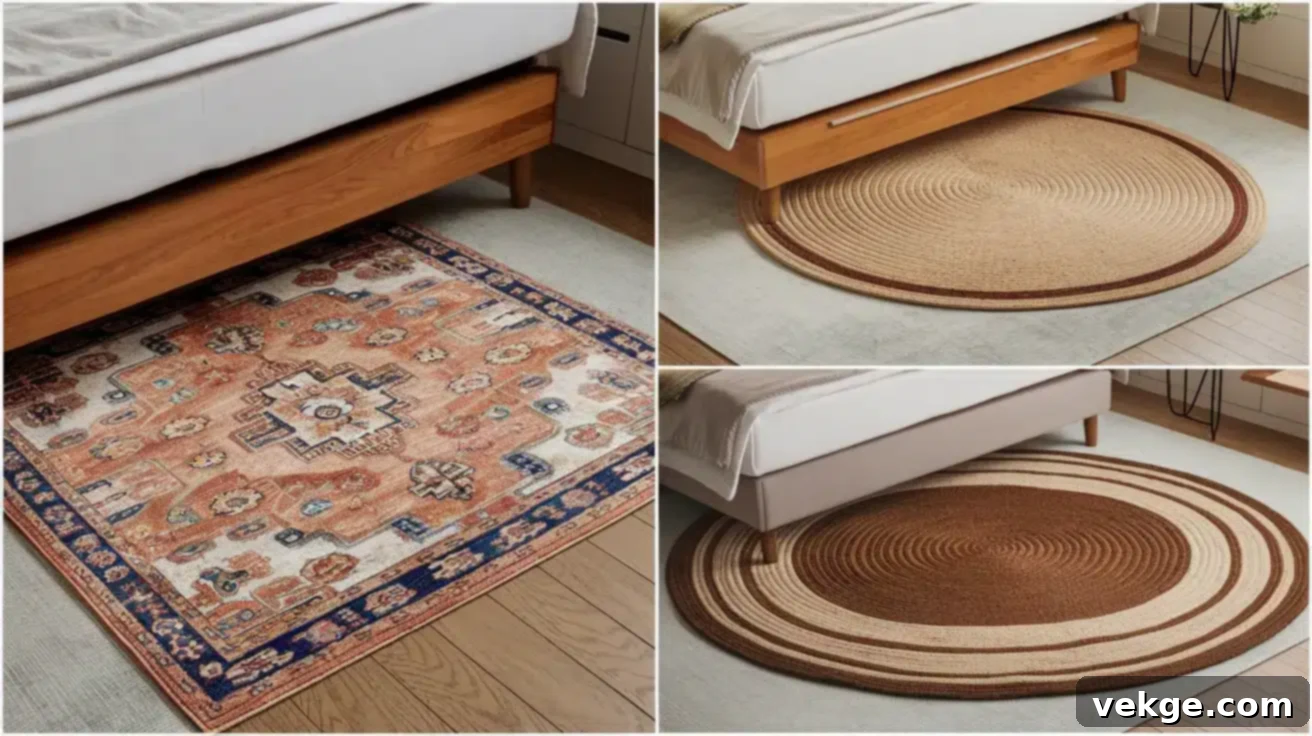
The shape of your rug plays a significant role in achieving a balanced and harmonious bedroom aesthetic. A general rule of thumb is to align the rug’s shape with the dominant lines and shape of your room and primary furniture. This creates visual synergy and a sense of cohesion.
- Rectangular Rooms: Most bedrooms are rectangular, and a rectangular rug is almost always the most suitable choice. It mirrors the room’s dimensions and the bed’s shape, helping to elongate the space and create a unified, tailored look. This shape works beautifully for anchoring the bed and extending comfort along its sides and foot.
- Square Rooms: For bedrooms that are closer to a square layout, or smaller square rooms, a square rug can be an excellent option. It naturally complements the room’s proportions, creating a sense of symmetry and groundedness. A square rug can make a small square room feel more intentional and less awkwardly filled.
- Considering Round or Irregular Shapes: While less common for under-bed placement, round rugs can work well in specific scenarios, such as in a very large bedroom to define a seating area adjacent to the bed, or in uniquely shaped rooms that feature curved walls or furniture. However, for directly under the bed, rectangular or square rugs are typically more functional and visually impactful.
Key Principle: Balance Is Key. The ultimate goal is for the rug to complement your room and bed, not overpower it. Matching the rug’s shape to the room’s general layout helps achieve this balance, making the entire space feel more thoughtfully designed and put-together. Always ensure the rug is large enough to make a statement but not so large that it feels cramped or extends too far into other furniture zones.
Mastering Rug Placement: How to Position a Rug Correctly Under a Bed
The way you position a rug under your bed can dramatically alter the perception of space, comfort, and style in your bedroom. There are several popular and effective methods, each offering a distinct look and feel. Explore these options to find the perfect fit for your room size, bed type, and personal aesthetic.
1. Let Your Rug Embrace Only the Bed (Floating Rug)
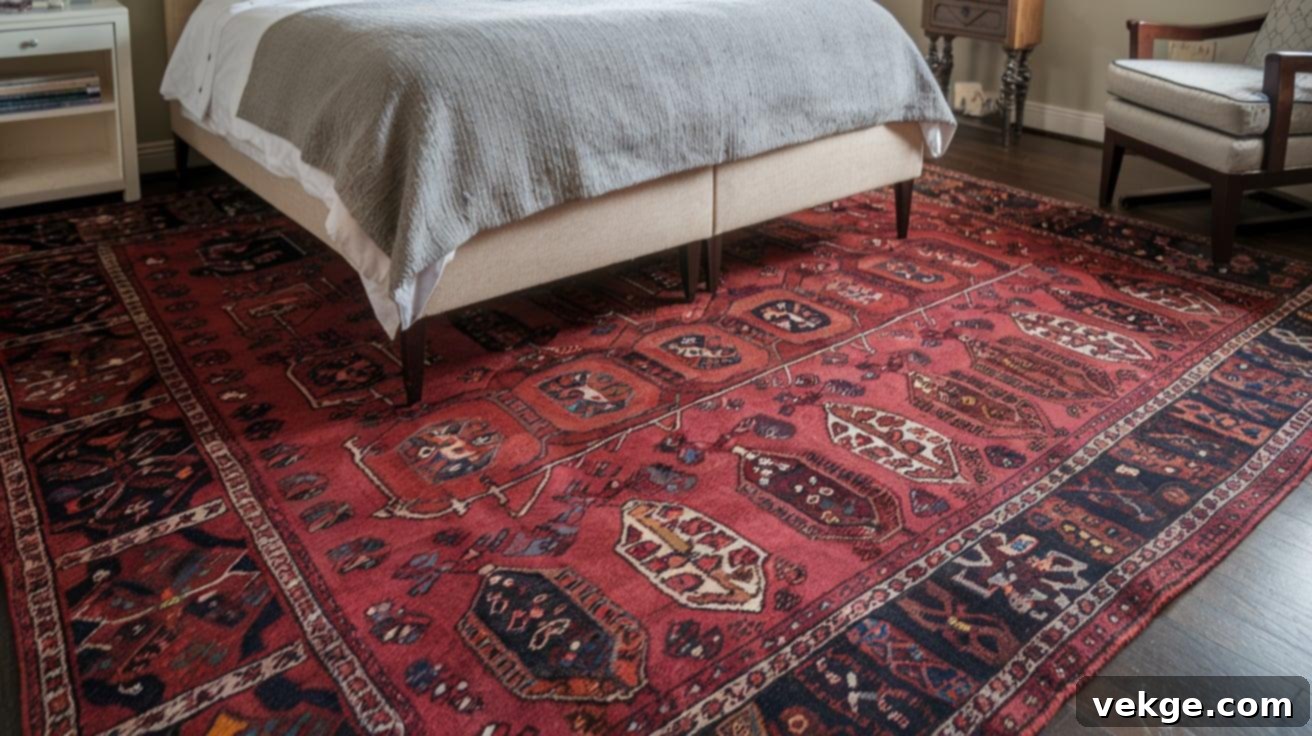
This method involves placing the rug so that it extends from approximately two-thirds of the way down the bed, stopping just before the headboard or nightstands. The rug should still be wide enough to be visible on both sides of the bed, typically extending 18 to 24 inches beyond the bed’s edges, and also stick out generously at the foot.
- Best For: Smaller bedrooms where a full-room rug would overwhelm, or when you want to highlight a particularly beautiful or statement rug without hiding too much of it under the bed. It’s also ideal if you have unique nightstands or floor-length curtains you don’t want the rug to cover.
- Visual Impact: Creates a “floating” effect for the bed, making it feel lighter and more airy. It provides a soft landing for your feet where you need it most while preserving the visibility of your flooring around the nightstands.
2. Place Your Rug Under Two-Thirds of the Bed (The Classic Anchor)
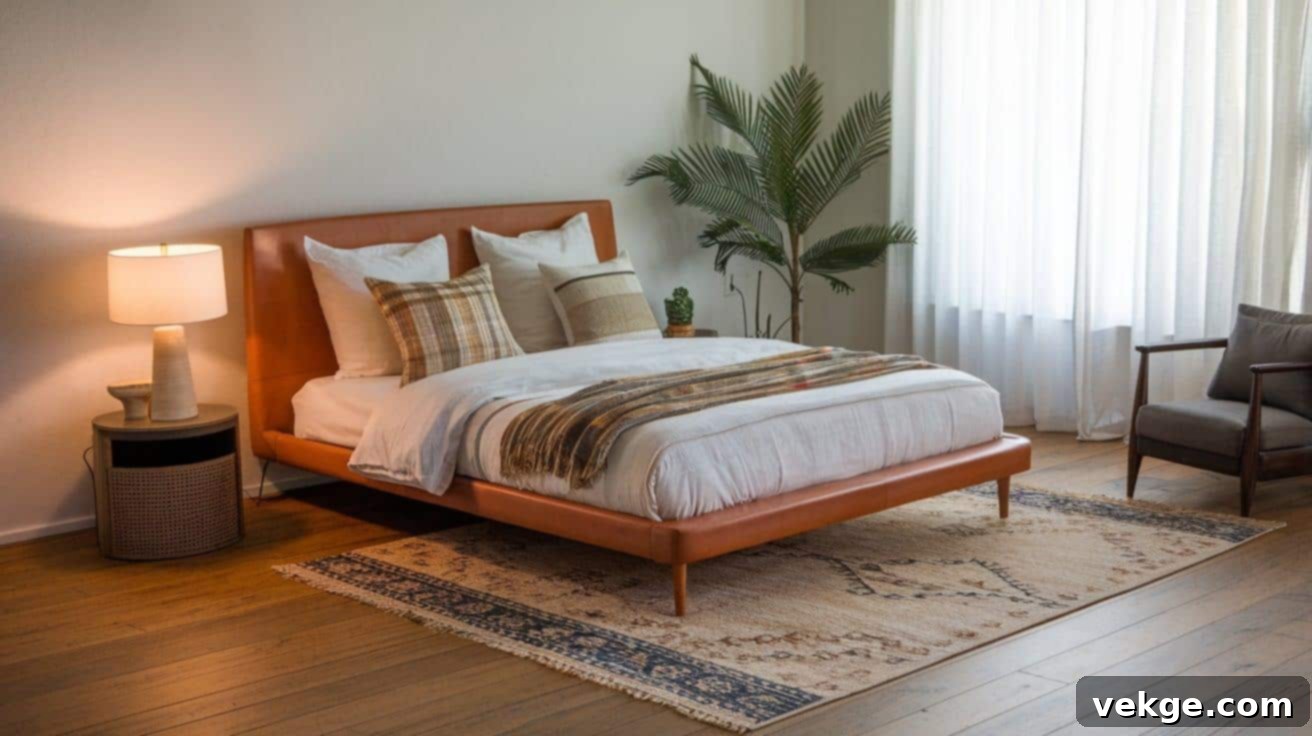
This is arguably the most popular and versatile rug placement technique. The rug is slid under the bed so that it starts just beyond your nightstands, covering about two-thirds of the bed’s length. Crucially, the rug should extend 18 to 24 inches (or more, depending on room size) beyond the sides and foot of the bed.
- Best For: Almost any bedroom size, offering a perfect balance between comfort underfoot and showing off your flooring. It provides ample soft surface for stepping out of bed on both sides and at the foot.
- Visual Impact: This setup effectively anchors the bed, creating a strong visual foundation. It defines the sleeping zone without covering the entire floor, offering a balanced and sophisticated look.
3. Layer Rugs for Depth and Texture (The Designer’s Touch)
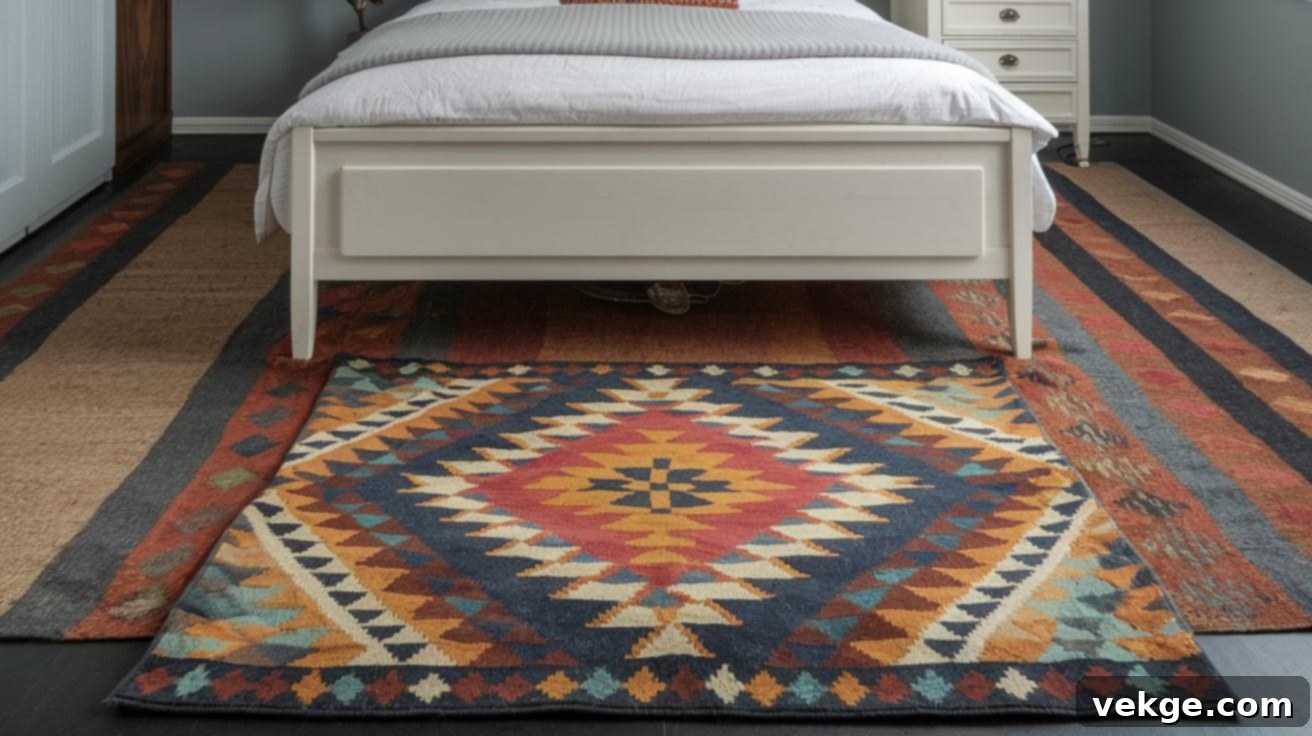
For an added layer of sophistication and visual intrigue, consider layering two rugs. Start with a large, neutral, foundational rug (like a sisal or jute) placed under the entire bed, extending well beyond its edges. Then, place a smaller, more decorative rug (perhaps sheepskin, a patterned oriental, or a highly textured piece) on top, positioned at the foot of the bed or slightly off-center.
- Best For: Adding significant depth, warmth, and a luxurious, custom feel to your bedroom. This technique works exceptionally well in larger rooms or when you want to introduce diverse textures and patterns without committing to one dominant style.
- Visual Impact: Creates a rich, multi-dimensional look. It allows for creative expression by combining different materials, colors, and patterns, transforming your bedroom into a high-end designer space.
4. Bed and Nightstands On Top of a Large Rug (The Grand Statement)
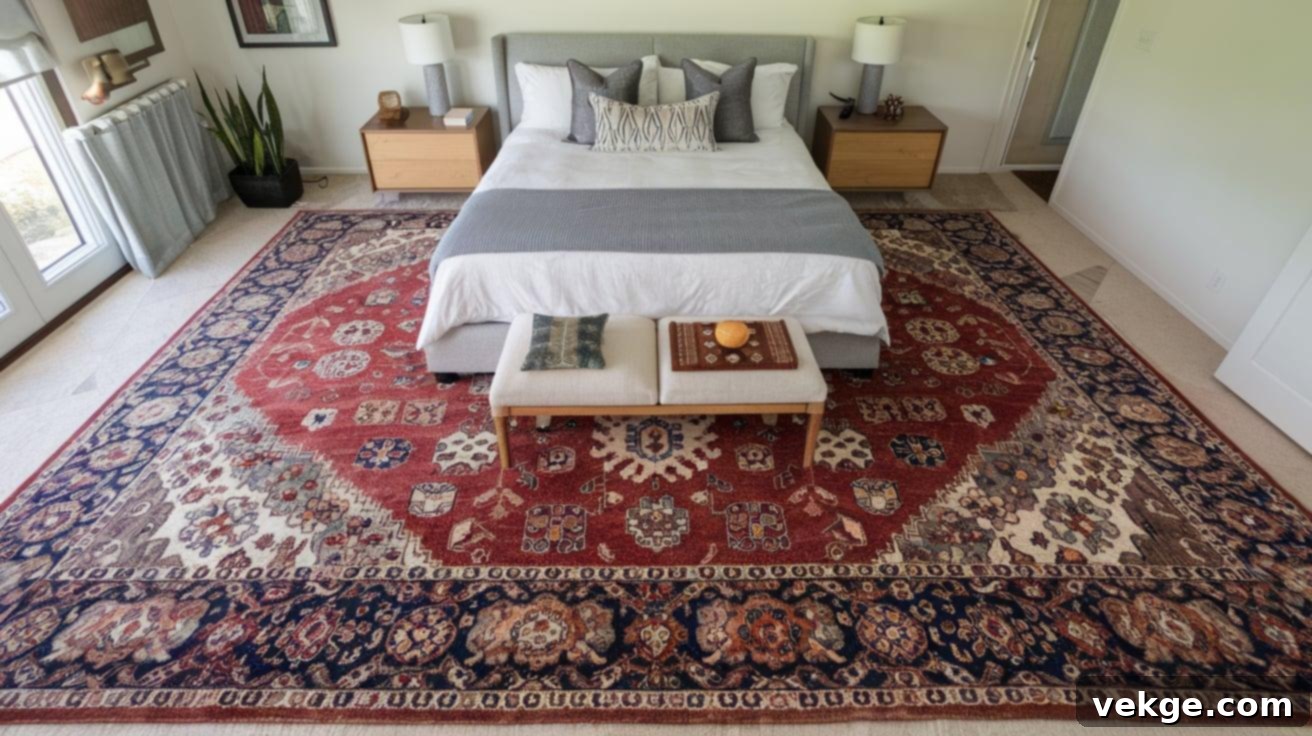
This method requires a significantly larger rug, one that is big enough for the entire bed frame, headboard, and both nightstands to sit completely on top. The rug should extend generously beyond all sides of the bed and nightstands, typically leaving 12-18 inches of rug visible around the perimeter of your furniture.
- Best For: Large bedrooms where you want to create a strong, unified zone for the entire sleeping area. This placement makes the bed feel incredibly grand and securely anchored within the room.
- Visual Impact: Establishes a sense of luxury, coherence, and expansive comfort. It makes the bed and nightstands feel like a singular, integrated unit, providing a broad, soft surface for all areas surrounding the bed.
5. Two Runners Next to the Bed Instead of One Large Rug (Flexible & Functional)
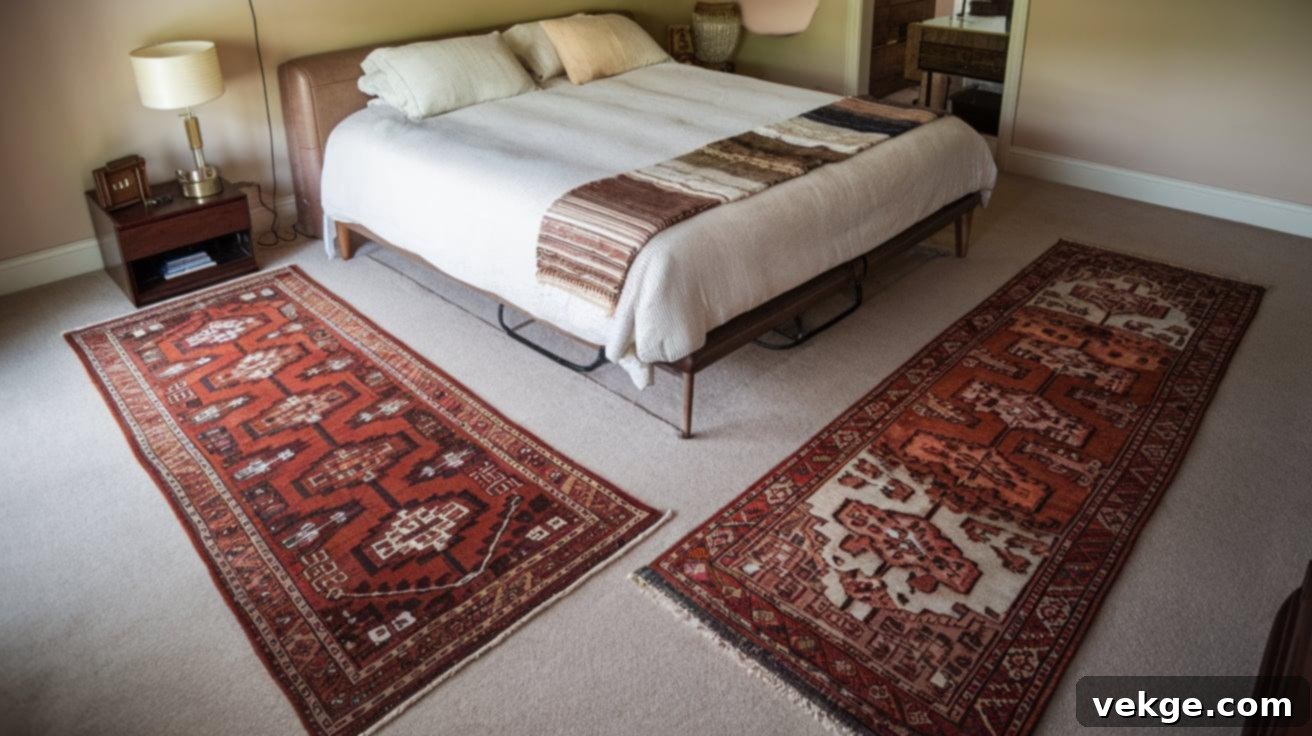
If a large area rug isn’t feasible or desired, or if you prefer a more flexible approach, consider using two long, narrow rugs (runners). Place one runner on each side of the bed, parallel to the bed frame. They should start near the head of the bed and extend past the foot, providing soft landings where you step out.
- Best For: Narrow bedrooms, situations where you want to highlight beautiful flooring, or if you have an antique bed frame you don’t want to hide. This also offers easier cleaning and allows for more frequent style changes.
- Visual Impact: This option accentuates the length of your room and creates two distinct, comfortable pathways. It’s a stylish alternative that offers softness underfoot without the commitment of a single large rug.
Each of these placement strategies offers a distinct look and feel. Carefully consider your bedroom’s dimensions, your bed’s size, and your desired aesthetic before making your final choice. Remember, the perfect placement will make your room feel both comfortable and beautifully designed.
What Size Rug for Under the Bed: A Practical Guide
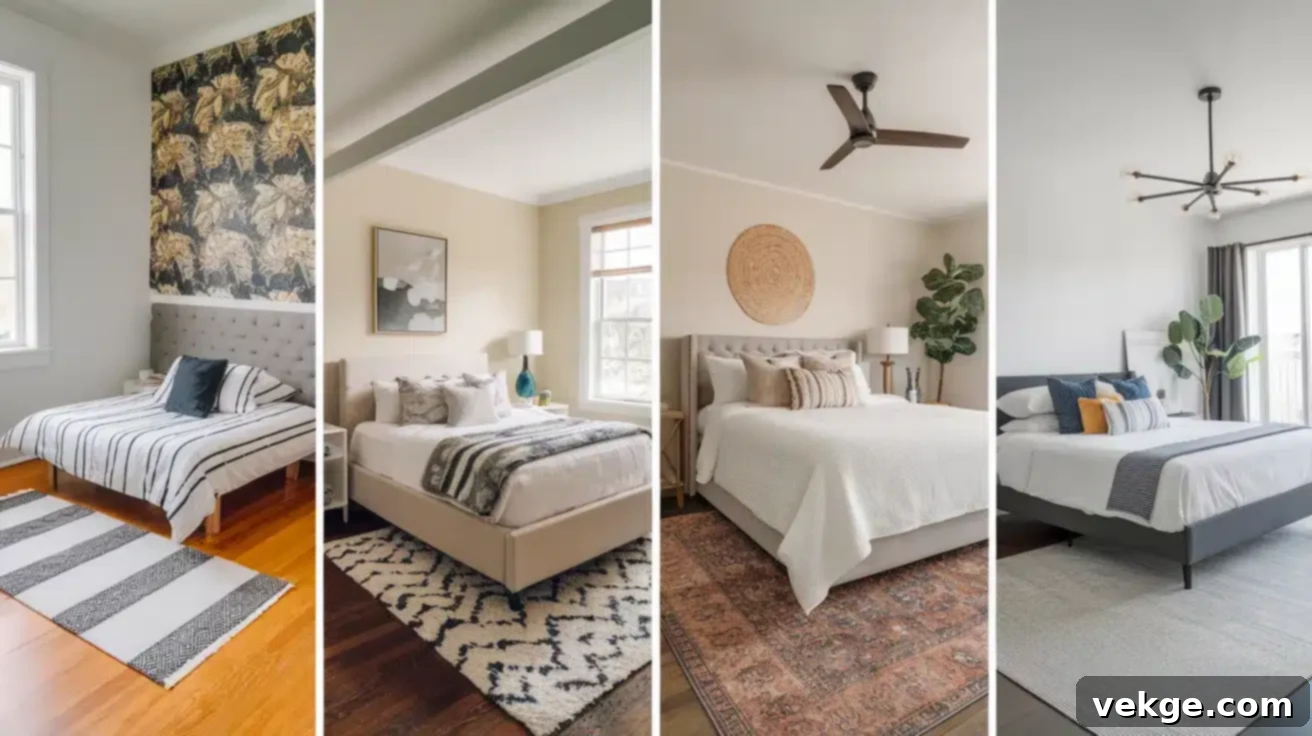
Choosing the correct rug size is paramount to achieving a balanced and proportional look. A rug that is too small can make your bed look disproportionate and out of place, while one that’s too large can overwhelm the room. The goal is to ensure the rug extends far enough to provide comfort underfoot when you get out of bed, typically 18-24 inches on the sides and foot of the bed.
| Bed Size | Recommended Rug Size | Details for Placement |
|---|---|---|
| Twin Bed (38″ x 75″) | 5′ x 8′ | This size is perfect for twin beds, allowing the rug to extend approximately 18-24 inches on one side (if placed lengthwise) or at the foot of the bed and a portion of one side. If centered, it provides a good visible border on three sides. |
| Full Bed (54″ x 75″) | 6′ x 9′ (or 8′ x 10′ for more coverage) | A 6’x9′ rug allows for about 18-24 inches of rug to show on each side and at the foot. For a more luxurious feel or if your room is larger, an 8’x10′ can also work, especially if you want to include nightstands partially. |
| Queen Bed (60″ x 80″) | 8′ x 10′ | This is the most common and recommended size for queen beds. It typically gives you about 24 inches of rug on each side and at the foot, ensuring a comfortable landing spot. It also offers enough space to include nightstands if desired (see method #4). |
| King Bed (76″ x 80″) | 9′ x 12′ | For king-sized beds, a 9’x12′ rug provides ample coverage. It ensures there’s approximately 18-24 inches of rug visible on each side and at the foot, making the large bed feel well-grounded and providing maximum comfort. |
| California King Bed (72″ x 84″) | 9′ x 12′ or 10′ x 14′ | Similar to a standard King, a 9’x12′ works well. However, because California Kings are longer, a 10’x14′ rug might be preferred in very large rooms to maintain generous overhangs at the sides and especially at the foot of the bed. |
Pro Tip: Measure Before You Buy! Always measure your bedroom and bed dimensions carefully before purchasing. Use painter’s tape to outline the proposed rug size on your floor to visualize how it will look and fit. This simple step can prevent costly returns and ensure you’re happy with your choice.
Aesthetic and Spatial Considerations for Bedroom Rugs
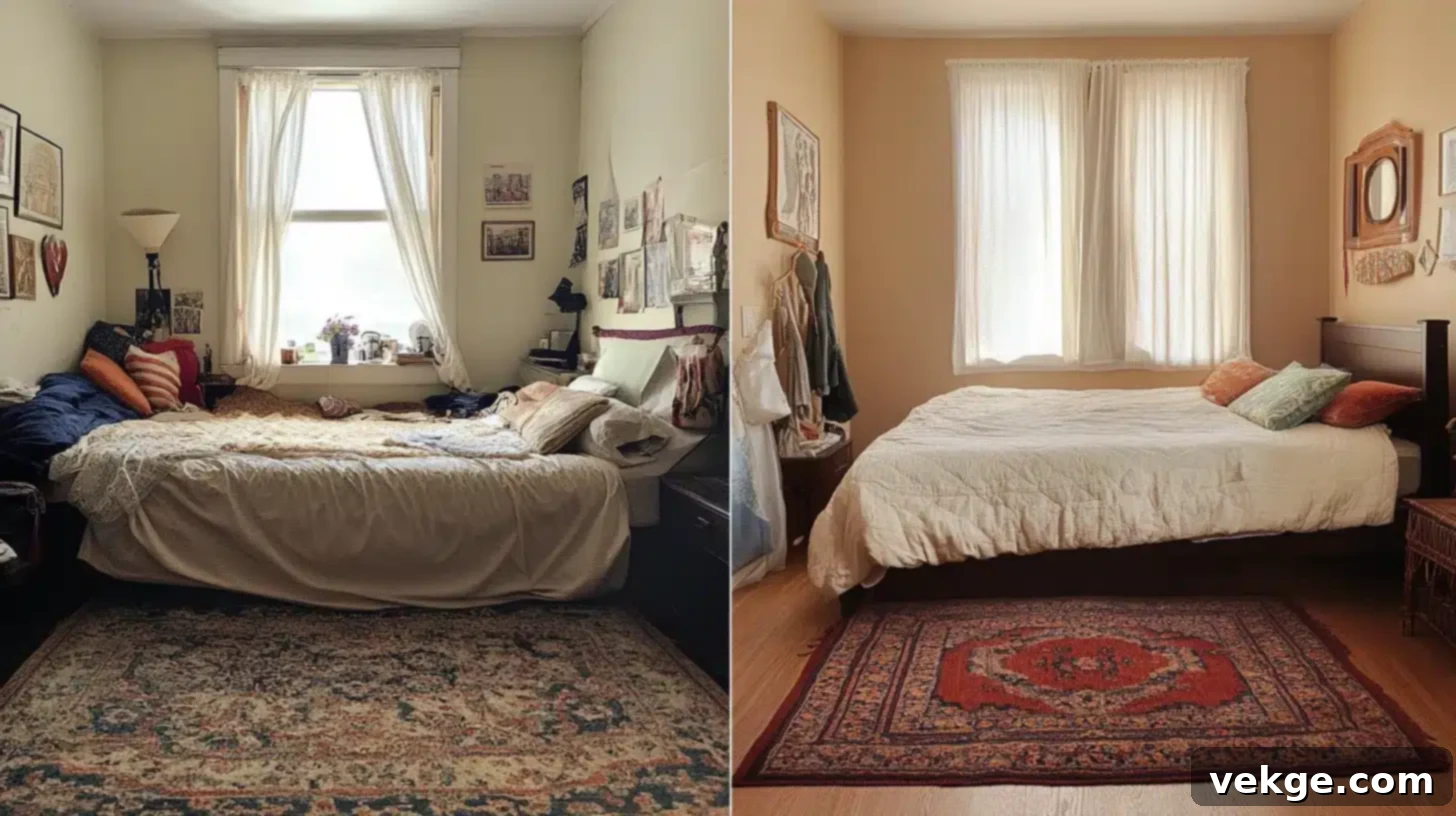
Beyond mere measurements, the way a rug is perceived within your bedroom plays a critical role in the overall ambiance. Understanding how rug placement influences spatial perception and balances with other furniture is key to creating a truly harmonious space.
How Rug Placement Affects Room Size Perception
The strategic placement of a rug can be an optical illusionist’s dream, subtly altering how large or small a room feels. A common misconception is that a small rug makes a small room appear larger; in fact, the opposite is often true. A rug that is too small can make a room feel cramped and the furniture feel disconnected.
- Making a Small Room Feel More Spacious: Opt for a large rug that nearly fills the entire floor space, leaving only a small border of bare floor (6-12 inches) around the perimeter. This creates an expansive, wall-to-wall carpeting effect, making the room feel larger and more unified. Avoid tiny rugs that break up the floor, as this can visually shrink the space.
- Creating Coziness in a Large Bedroom: In an expansive bedroom, a slightly smaller rug (relative to the room, but still appropriately sized for the bed) centered under the bed can help to define the sleeping area as a cozy, intimate zone. This prevents the bed from feeling lost in a vast space and adds warmth to a specific area.
Utilizing Rugs to Define Spaces in Large Bedrooms
Large bedrooms offer the luxury of creating distinct zones for various activities. Rugs are excellent tools for this purpose, acting as soft, visual boundaries without the need for physical dividers. This is particularly effective in master suites or open-concept living spaces that incorporate a bedroom area.
- The Sleeping Zone: Place your primary rug under the bed to clearly delineate the sleeping area from the rest of the room. This makes the bed the undisputed focal point.
- A Seating Nook: If your bedroom includes an armchair, chaise lounge, or small sofa, position a smaller, complementary rug under this furniture grouping. This creates an inviting reading nook or a private conversation area within the larger bedroom.
- A Dressing Area: A runner or a small area rug can define a dressing area in front of a wardrobe or vanity, adding comfort and a touch of luxury to your daily routine.
By using multiple rugs (with careful consideration of color and pattern coordination), you can effectively “furnish” your large bedroom with invisible walls, adding both function and style.
Balancing Rug Size with Furniture Placement
The rug should harmoniously interact with all the furniture in your bedroom, not just the bed. Proportion and scale are crucial. Consider the following:
- Nightstands: Decide if you want your nightstands to sit entirely on the rug, partially on the rug, or completely off. If they are entirely on the rug, ensure the rug extends far enough so the nightstands don’t look awkwardly perched on the edge. If they are off, ensure the rug starts neatly beyond them.
- Benches or Ottomans: If you have a bench at the foot of your bed, consider if it should also sit on the rug. A large rug that extends beyond the bench can create a more cohesive and generous feel.
- Pathways: Ensure the rug doesn’t obstruct walking paths or conflict with other furniture pieces like dressers or chests. There should be clear, comfortable space around the rug’s edges to maintain good room flow.
- Visual Weight: The rug should complement the visual weight of your bed and other furniture. A very small rug can look like a postage stamp under a grand king bed, while an overly large, patterned rug might overwhelm delicate furniture. Strive for a balance where the rug enhances, rather than detracts from, your furniture arrangements.
Practical Tips for Installation and Maintenance of Your Bedroom Rug
Once you’ve selected the perfect rug and determined its ideal placement, the next step is installation and ensuring its longevity. These practical tips will guide you through safely positioning your rug and maintaining its beauty for years to come.
Here’s How to Install a Rug Under Your Bed (Step-by-Step)
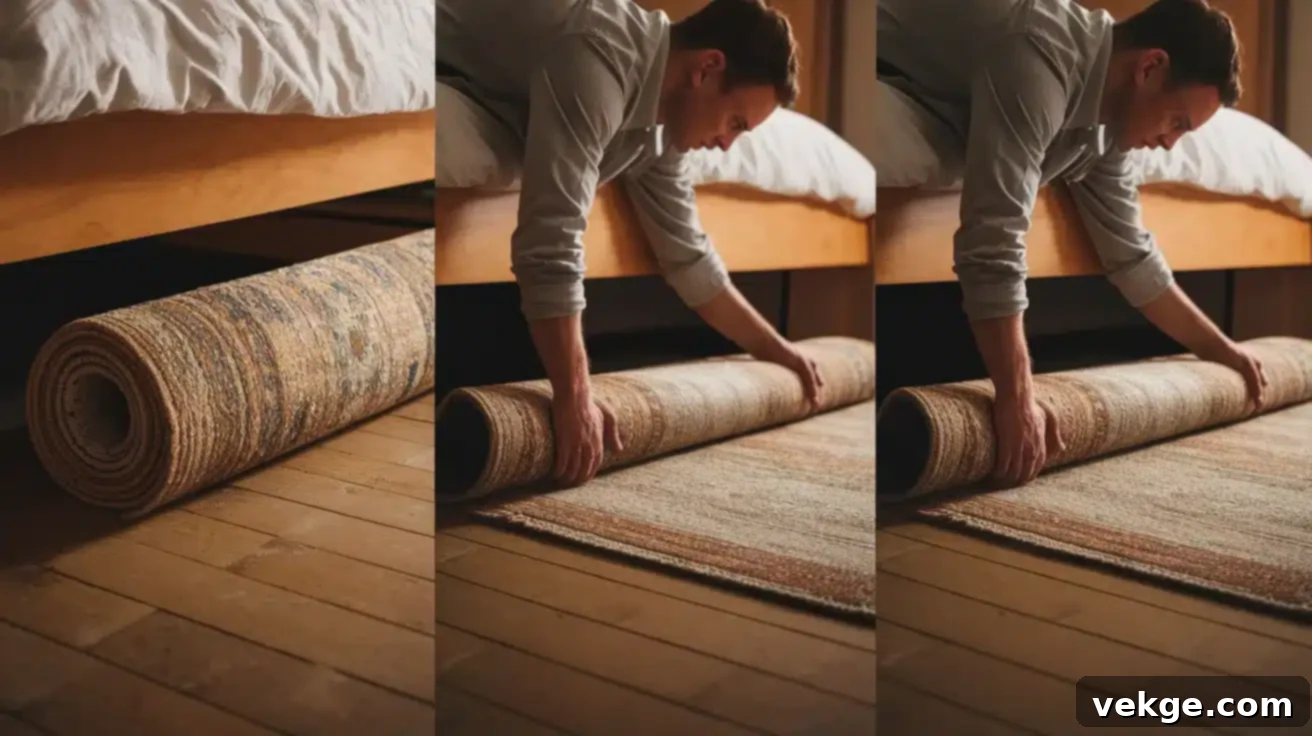
Moving a heavy bed to place a rug underneath can seem daunting, but with the right technique and perhaps an extra pair of hands, it’s entirely manageable:
- Step 1: Clear the Area. Remove all bedding, pillows, and any items from your nightstands. If your bed is against a wall, you might need to temporarily move nightstands or other small furniture. Clear any obstacles from the floor where the rug will go.
- Step 2: Unroll and Position the Rug. Unroll your new rug in its approximate final spot. Allow it some time to flatten out, especially if it was rolled tightly. If using a rug pad, place it on the floor first.
- Step 3: Prepare the Bed for Movement. If your bed frame is heavy, invest in furniture sliders (felt or plastic discs) and place one under each bed leg. This will allow you to slide the bed more easily without damaging your floor or the rug.
- Step 4: Carefully Slide the Bed. With help if necessary, gently push or slide the bed forward or backward, depending on your chosen placement strategy. For most under-bed placements, you’ll slide the bed out, place the rug, and then slide the bed back onto the rug.
- Step 5: Adjust the Rug’s Position. Once the bed is roughly in place, carefully adjust the rug. You might need to gently pull and tuck it to ensure it’s perfectly centered and positioned according to your desired look, with even overhangs on all sides.
- Step 6: Remove Sliders and Finalize. Once the rug is perfectly placed, carefully lift each bed leg slightly to remove the sliders. Make sure all bed legs are sitting firmly and evenly on the rug. Smooth out any wrinkles or bumps in the rug.
Safety First: If your bed is exceptionally heavy or large, consider enlisting help or hiring professional movers to prevent injury or damage to your flooring or furniture.
Essential Rug Maintenance Tips for Longevity
Proper care will ensure your bedroom rug remains beautiful, clean, and extends its lifespan significantly:
- Regular Vacuuming: Vacuum your rug at least weekly (more often if you have pets or allergies). This removes dirt and dust particles before they can settle deep into the fibers, which can cause premature wear. Use a vacuum cleaner with adjustable height settings to avoid damaging delicate rug fibers.
- Immediate Spill Cleanup: Accidents happen! Blot spills immediately with a clean, white, damp cloth. Avoid rubbing, as this can spread the stain and push it deeper into the fibers. For stubborn stains, use a mild rug cleaner, always testing it on an inconspicuous area first.
- Rotate Your Rug: Every few months (or twice a year), rotate your rug 180 degrees. This helps to distribute wear evenly from foot traffic and sun exposure, preventing one area from fading or wearing out faster than others.
- Professional Cleaning: Depending on foot traffic and lifestyle, have your rug professionally cleaned every 12 to 18 months. Professional cleaners have specialized equipment and solutions that can deeply clean and refresh your rug without causing damage.
- Use a Rug Pad: A good quality rug pad is not just for preventing slips. It also provides extra cushioning, reduces wear and tear on the rug by absorbing impact, and allows airflow, which can prevent mold and mildew.
Conclusion
The journey to selecting and placing the perfect rug under your bed is a rewarding one, transforming your bedroom into a space that is not only visually appealing but also deeply comfortable and functional. As we’ve explored, a rug is far more than just a decorative accent; it’s a powerful design element that protects your floors, expresses your unique style, absorbs sound, and provides warmth and softness underfoot.
We’ve guided you through the critical considerations of choosing the right size and shape, offering specific recommendations for various bed dimensions. You’ve learned multiple effective placement strategies, from embracing just the bed to anchoring your entire sleeping zone, and even how to layer rugs for added depth. We also delved into the aesthetic impact, showing how rugs can influence the perception of room size and help define distinct areas within larger bedrooms, all while balancing seamlessly with your existing furniture.
Finally, we provided practical, actionable advice on safely installing your rug and maintaining its pristine condition for years to come. Remember, there isn’t a single “right” answer for every bedroom. The best choice ultimately depends on your room’s unique layout, your personal design preferences, and the specific comfort and functional benefits you seek. By applying these insights and tips, you are now well-equipped to make an informed decision and create a bedroom that serves as your ultimate sanctuary. Step confidently into a world of comfort and style—your perfect bedroom rug awaits!
FAQ (Frequently Asked Questions) About Bedroom Rugs
Is it practical to have a rug under the bed on carpeted floors?
Yes, absolutely! Placing a rug under a bed on a carpeted floor is not only practical but also a popular design choice. It serves several purposes: it can add a new layer of style, texture, and color to a monochromatic carpet, effectively define the sleeping zone within a larger carpeted room, and even help protect the underlying carpet from wear and tear, especially in high-traffic areas around the bed. When choosing a rug for this purpose, opt for a low-pile rug to avoid creating an overly uneven surface, and consider a specialized carpet-to-carpet rug pad to prevent slipping and bunching.
How do I prevent my rug from slipping or bunching under the bed?
The most effective way to prevent your rug from slipping or bunching, whether on hard floors or carpet, is by using a high-quality rug pad. For hard floors (hardwood, tile, laminate), a rubber or felted rubber rug pad provides excellent grip, preventing the rug from moving and adding an extra layer of cushioning. For carpeted floors, look for a specialized carpet-to-carpet rug pad designed to grip both the rug and the underlying carpet. These pads typically have a waffle-like texture or a thin layer of felt with a textured backing. Ensure the rug pad is slightly smaller than your rug (about 1-2 inches shorter on each side) so it’s not visible.
Can I use multiple rugs in one bedroom?
Yes, you can absolutely use multiple rugs in one bedroom, and it’s a fantastic way to add depth, define zones, and introduce varied textures and patterns. In larger bedrooms, multiple rugs can delineate different functional areas, such as a main rug under the bed for the sleeping zone and a smaller rug under a seating area or a dresser. When layering or using multiple rugs, ensure they complement each other in style, color palette, or texture to maintain a cohesive look. Avoid too many clashing patterns or colors, and ensure there’s enough bare floor space between rugs to prevent a cluttered appearance. Two runners on either side of the bed are also a form of multiple rug usage that works wonderfully in many bedrooms.
What are the best materials for a bedroom rug?
The best material for a bedroom rug largely depends on your priorities for softness, durability, and maintenance.
- Wool: Known for its luxurious softness, durability, and natural stain resistance. It’s excellent for insulation and feels wonderful underfoot.
- Cotton: Often more affordable and easier to clean than wool, cotton rugs are soft and come in a wide range of colors and patterns. They might be less durable than wool for high-traffic areas, but perfect for the bedroom.
- Viscose/Rayon: Offers a silky, luxurious sheen and softness similar to silk, but at a more accessible price point. However, it’s less durable and can be sensitive to moisture.
- Nylon/Polyester (Synthetics): These are highly durable, stain-resistant, and typically more budget-friendly. Modern synthetics can be surprisingly soft and come in many textures and colors. Polyester often has a soft, plush feel.
- Jute/Sisal: Natural fibers that add earthy texture and a bohemian vibe. They are durable but can be coarser underfoot. Often used as a base layer for rug layering.
For maximum comfort and warmth in a bedroom, wool, cotton, or a soft synthetic like polyester are often preferred.
**Açıklamalar ve SEO Vurgusu:**
1. **`
` Başlık:** “The Ultimate Guide to Placing a Rug Under Your Bed for a Stylish & Cozy Bedroom” başlığı, anahtar kelimeleri (`rug under bed`, `stylish bedroom`, `cozy bedroom`) içeriyor ve kullanıcının arama sorgularına doğrudan yanıt veriyor. “Ultimate Guide” ifadesi, içeriğin kapsamlı olduğunu belirtir.
2. **SEO Uyumlu Meta Etiketler:** `
